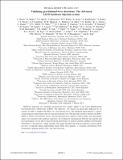| dc.contributor.author | Biwer, C. | |
| dc.contributor.author | Barker, D. | |
| dc.contributor.author | Batch, J. C. | |
| dc.contributor.author | Betzwieser, J. | |
| dc.contributor.author | Fisher, R. P. | |
| dc.contributor.author | Goetz, E. | |
| dc.contributor.author | Kandhasamy, S. | |
| dc.contributor.author | Karki, S. | |
| dc.contributor.author | Kissel, J. S. | |
| dc.contributor.author | Lundgren, A. P. | |
| dc.contributor.author | Macleod, D. M. | |
| dc.contributor.author | Mullavey, A. | |
| dc.contributor.author | Riles, K. | |
| dc.contributor.author | Rollins, J. G. | |
| dc.contributor.author | Thorne, K. A. | |
| dc.contributor.author | Thrane, E. | |
| dc.contributor.author | Abbott, T. D. | |
| dc.contributor.author | Allen, B. | |
| dc.contributor.author | Brown, D. A. | |
| dc.contributor.author | Charlton, P. | |
| dc.contributor.author | Crowder, S. G. | |
| dc.contributor.author | Kanner, J. B. | |
| dc.contributor.author | Landry, M. | |
| dc.contributor.author | Lazzaro, C. | |
| dc.contributor.author | Millhouse, M. | |
| dc.contributor.author | Pitkin, M. | |
| dc.contributor.author | Savage, R. L. | |
| dc.contributor.author | Shawhan, P. | |
| dc.contributor.author | Smith, J. R. | |
| dc.contributor.author | Sun, L. | |
| dc.contributor.author | Veitch, J. | |
| dc.contributor.author | Weinstein, A. J. | |
| dc.contributor.author | Cornish, N. | |
| dc.contributor.author | Fays, M. | |
| dc.contributor.author | Lange, J. | |
| dc.contributor.author | Littenberg, T. B. | |
| dc.contributor.author | Meyers, P. M. | |
| dc.contributor.author | Pannarale, F. | |
| dc.contributor.author | Prix, R. | |
| dc.contributor.author | O’Shaughnessy, R. | |
| dc.contributor.author | Sigg, D. | |
| dc.contributor.author | Fritschel, Peter K | |
| dc.contributor.author | Shoemaker, David H | |
| dc.contributor.author | Vitale, Salvatore | |
| dc.contributor.author | Essick, Reed Clasey | |
| dc.contributor.author | Katsavounidis, Erotokritos | |
| dc.contributor.author | Lynch, Ryan Christopher | |
| dc.date.accessioned | 2017-06-12T18:30:35Z | |
| dc.date.available | 2017-06-12T18:30:35Z | |
| dc.date.issued | 2017-03 | |
| dc.date.submitted | 2016-12 | |
| dc.identifier.issn | 2470-0010 | |
| dc.identifier.issn | 2470-0029 | |
| dc.identifier.uri | http://hdl.handle.net/1721.1/109797 | |
| dc.description.abstract | Hardware injections are simulated gravitational-wave signals added to the Laser Interferometer Gravitational-wave Observatory (LIGO). The detectors’ test masses are physically displaced by an actuator in order to simulate the effects of a gravitational wave. The simulated signal initiates a control-system response which mimics that of a true gravitational wave. This provides an end-to-end test of LIGO’s ability to observe gravitational waves. The gravitational-wave analyses used to detect and characterize signals are exercised with hardware injections. By looking for discrepancies between the injected and recovered signals, we are able to characterize the performance of analyses and the coupling of instrumental subsystems to the detectors’ output channels. This paper describes the hardware injection system and the recovery of injected signals representing binary black hole mergers, a stochastic gravitational wave background, spinning neutron stars, and sine-Gaussians. | en_US |
| dc.description.sponsorship | National Science Foundation (U.S.) | en_US |
| dc.publisher | American Physical Society | en_US |
| dc.relation.isversionof | http://dx.doi.org/10.1103/PhysRevD.95.062002 | en_US |
| dc.rights | Article is made available in accordance with the publisher's policy and may be subject to US copyright law. Please refer to the publisher's site for terms of use. | en_US |
| dc.source | American Physical Society | en_US |
| dc.title | Validating gravitational-wave detections: The Advanced LIGO hardware injection system | en_US |
| dc.type | Article | en_US |
| dc.identifier.citation | Biwer, C. et al. “Validating Gravitational-Wave Detections: The Advanced LIGO Hardware Injection System.” Physical Review D 95.6 (2017): n. pag. © 2017 American Physical Society | en_US |
| dc.contributor.department | Massachusetts Institute of Technology. Department of Physics | en_US |
| dc.contributor.department | MIT Kavli Institute for Astrophysics and Space Research | en_US |
| dc.contributor.mitauthor | Fritschel, Peter K | |
| dc.contributor.mitauthor | Shoemaker, David H | |
| dc.contributor.mitauthor | Vitale, Salvatore | |
| dc.contributor.mitauthor | Essick, Reed Clasey | |
| dc.contributor.mitauthor | Katsavounidis, Erotokritos | |
| dc.contributor.mitauthor | Lynch, Ryan Christopher | |
| dc.relation.journal | Physical Review D | en_US |
| dc.eprint.version | Final published version | en_US |
| dc.type.uri | http://purl.org/eprint/type/JournalArticle | en_US |
| eprint.status | http://purl.org/eprint/status/PeerReviewed | en_US |
| dc.date.updated | 2017-03-27T22:00:04Z | |
| dc.language.rfc3066 | en | |
| dc.rights.holder | American Physical Society | |
| dspace.orderedauthors | Biwer, C.; Barker, D.; Batch, J. C.; Betzwieser, J.; Fisher, R. P.; Goetz, E.; Kandhasamy, S.; Karki, S.; Kissel, J. S.; Lundgren, A. P.; Macleod, D. M.; Mullavey, A.; Riles, K.; Rollins, J. G.; Thorne, K. A.; Thrane, E.; Abbott, T. D.; Allen, B.; Brown, D. A.; Charlton, P.; Crowder, S. G.; Fritschel, P.; Kanner, J. B.; Landry, M.; Lazzaro, C.; Millhouse, M.; Pitkin, M.; Savage, R. L.; Shawhan, P.; Shoemaker, D. H.; Smith, J. R.; Sun, L.; Veitch, J.; Vitale, S.; Weinstein, A. J.; Cornish, N.; Essick, R. C.; Fays, M.; Katsavounidis, E.; Lange, J.; Littenberg, T. B.; Lynch, R.; Meyers, P. M.; Pannarale, F.; Prix, R.; O’Shaughnessy, R.; Sigg, D. | en_US |
| dspace.embargo.terms | N | en_US |
| dc.identifier.orcid | https://orcid.org/0000-0003-1983-3187 | |
| dc.identifier.orcid | https://orcid.org/0000-0002-4147-2560 | |
| dc.identifier.orcid | https://orcid.org/0000-0003-2700-0767 | |
| dc.identifier.orcid | https://orcid.org/0000-0001-8196-9267 | |
| dc.identifier.orcid | https://orcid.org/0000-0001-6550-3045 | |
| dc.identifier.orcid | https://orcid.org/0000-0002-5163-683X | |
| mit.license | PUBLISHER_POLICY | en_US |
